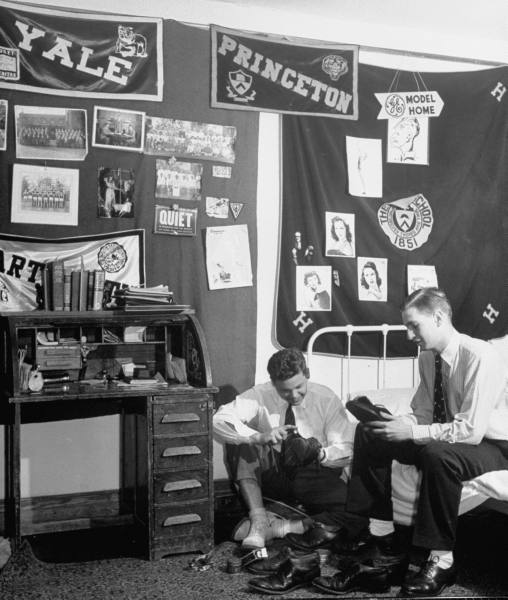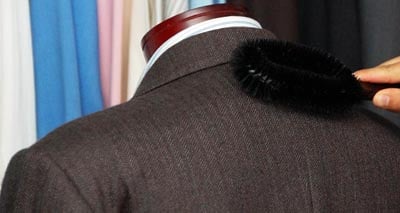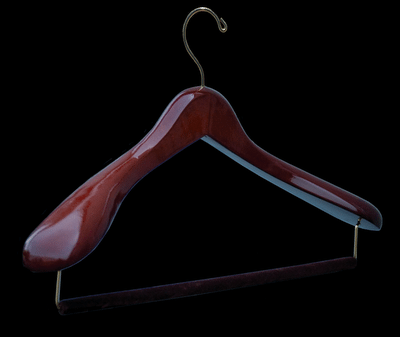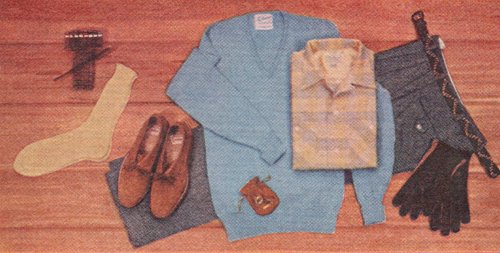
Introduction
First in How to Build Your Wardrobe Part I we listed the wardrobe basics for several different kinds of men. Next in How to Build Your Wardrobe Part II we went over these basic items in more detail. In How to Build Your Wardrobe Part III we covered hats and other accessories. In this final installment of the wardrobe series, we’ll cover how to maintain and protect your investment.
Maintaining a Wardrobe in 2010
We live in a disposable society full of waste, one marked by single-use plastic water bottles and single-use plastic grocery bags. It’s little wonder that this way of doing business has spread to the clothing industry; instead of purchasing clothes whose looks improve over a decade, we select items based on price alone, items built with shoddy workmanship and poor quality materials. After a year when they wear out (as they were made to), we throw them away, the logic being it’s cheaper to buy new than repair the old.
I challenge this way of thinking, and offer an alternative. When building your wardrobe, invest in quality items that may initially be more expensive (although not always– click here for dressing sharp on less than $200), but over the long run are a better investment. A more expensive piece of clothing that lasts for decades will end up costing less than a cheaper item that quickly wears out and must be replaced over and over again.
Maintaining quality clothing and footwear requires care, but the reward is a personal presentation that gets better with time. Imagine shoes that get more comfortable and look better every year you own them – shoes that you wear at your daughter’s baptism and two decades later at her wedding.
This article is about the care required to maintain your clothing and footwear for decades.
Why Maintain and Protect Your Wardrobe?
1. Your clothing will look better.
Good clothing that is properly maintained always looks better than more expensive clothing that is neglected. The shine of a pair of buffed shoes, the complimentary fit of tailored trousers, and the sharp collar points of a freshly pressed dress shirt are reflections of well maintained clothing.
2. Your clothing will last longer.
Even quality clothing will fall apart if abused; sadly we are so used to menswear being disposable that the idea of ironing, brushing, and repairing our clothing is a foreign concept to many of us. The simple fact is this: well made garments can last for decades. Recently the Duke of Windsor’s wardrobe was sold at auction. More amazing than the fact that his clothing was still wearable (despite much of it being 70 years old) was the way a person could see how a former King of England was so attached to his favorite shirts that he repaired them with material cut from his own shirt tails to ensure the fabrics matched.
3. It will save you money.
An ounce of prevention is worth a pound of cure. All it takes is a few moths to do hundreds if not thousands of dollars worth of damage to your fine woolen clothing. Although re-weaving can in some cases repair holes up to one inch in diameter, why go through this painfully expensive process when proper preparation before packing can eliminate the risk of your suits being eaten? Protecting your wardrobe costs much less than having to buy replacement clothing every few years.
4. It instills discipline.
Proper wardrobe maintenance requires discipline; it’s ongoing and requires us to carve time out of our busy schedules to address it. Like servicing your automobile, tending to your home, and maintaining a strong relationship, the discipline required to properly and consistently maintain your wardrobe is a small reflection of the larger way in which you live your life.
Day to Day Maintenance
Brushing Your Suit Jackets and Trousers
All it takes is 30 seconds and a clean brush with stiff bristles to clean your clothes after each wearing. Brushing your suit jacket and trousers after each wear is important because it removes the dirt and food that has accumulated on the outer layers before they have the chance to settle into the fabric. Once this happens, the fabric can be damaged as the food bits decompose and/or attract insects. A huge upside to brushing your clothing is that it can double to triple the time between visits to the cleaners – simply brush and air out and you’ll be ready to go in a 24 hours.

Brushing a Men’s Jacket
Polishing and Protecting Your Footwear
We’ve already written about this extensively – Visit the classic AOM articles “How to shine your shoes” and “How to waterproof your shoes.”
Minor Garment Repairs & Alterations
Most large problems start off as small ones; it’s our lack of immediate action that leads to these issues escalating. Are your trousers too tight in the backside? You’ll very likely split the seam before you lose the weight. Best to have the trousers opened up an inch – they’ll look and feel better. Does that suit jacket button look like it’s going to fall off? Cut the string and repair it tonight; once it falls off and you lose the button, you’ll either spend hours trying to match it or spend money on an entirely new set.
A Man Needs to Know How to Iron His Clothing
I learned the fine art of ironing while an officer candidate at OCS; every night, during our “sleep time,” we’d spend hours preparing for inspections which meant uniforms had to be crisp, clean, and perfectly pressed. Although non-iron fabrics are quite popular, especially with traveling businessmen, they fail to compare with the look and feel of freshly pressed 100% cotton shirts. Ironing is what gives a shirt its body and character; the sharp creases at the collar, the perfectly pressed French cuffs, and the smooth drape of a perfectly pressed back signal attention to detail. Here’s how to iron a dress shirt properly.
Steaming – Know What You Are Doing
Steaming, whether using a professional steaming machine or an iron with this built-in function, is an excellent way to quickly remove wrinkles from delicate fabrics. Unlike ironing, there is less chance you’ll damage the fabric as you do not touch it with hot metal. However, steam is not as effective on cotton for this very reason, and it’s almost impossible to get a crisp look when steaming a cotton shirt. Also, great care should be taken when steaming a wool jacket or other pieces of clothing that are shaped; it’s very easy to blow out seams and create a billowed look where the fabrics connect.
How to Properly Store Men’s Clothing & Shoes
General Guidance & Environment
Try to store your clothing and footwear in a cool, dry, clean, and dark environment. All four of these factors are important to retard bacterial growth, discourage insect infestation, and prevent UV damage and color fading. If clothing is going to be hung for more than 1 month without being worn, consider placing it in a breathable garment bag to prevent dust accumulation.
Hangers
As Washington D.C. image consultant Grant Harris likes to say, “Wire hanger are useful when you lock your keys in your car – not in your closet.” His point is wire hangers can permanently damage your clothing, especially woolens as they create unsightly creases that are very difficult to remove. Spend a little extra and purchase handsome wood shirt hangers (at least ¼ inch thick) and wood suit hangers (at least 1+ inch thick at the shoulders). In the case of the suit hangers, you’ll spend at least $5 to $20 each, but this is a small price to pay to properly hang a $500+ jacket.

A proper Suit Hanger – Photo courtesy The Hanger Project
Shoe Trees
Wooden shoe trees should be a mandatory purchase for any man who wants to get more than a couple years out of his leather shoes. They maintain the shape of the shoe and prevent the leather from warping in a way that would promote premature cracking. They also absorb excess moisture from the soles and leather.
Wool Protection – Moth Balls, Cedar, Lavender and a Tight Seal
Wool is a luxury fabric with amazing properties and a long history of use in society; unfortunately, it’s expensive and highly susceptible to damage if not cleaned and stored properly. It’s important that before storing and sealing your wool clothing you have it professionally cleaned. Although I’m not a fan of the chemicals used in the dry cleaning process, they do kill the microscopic insect eggs that have potentially been laid on your jacket. If you have a large freezer that’s not in use, it’s also possible to kill any eggs by vacuum sealing the clothing and then freezing it for 72 hours.
Moth balls are a commonly used insect deterrent. However, they are a harsh option as they rely on a vacuum seal that traps in toxic fumes, and they often leave a bad smell on clothing. I personally prefer natural alternatives to moth balls such as cedar, lavender, rosemary, cloves, and other aromatic repellants. Although they are somewhat less effective than moth balls and need to be replaced and refreshed, these choices do not contain paradichlorobenzene.
Finally, be careful with mixing un-cleaned wool with dry cleaned wool – the dry cleaning process only kills eggs on the garment; it provides no protection days after the cleaning. Hence one infested wool cap thrown on top of a stack of wool suits to be sealed for the summer can lead to disaster.
Cotton Protection – Dry & Cool & Breathable
With cotton, you have little to worry about when it comes to moths. However, cotton can still be permanently damaged if it’s exposed to moist conditions for prolonged periods – mildew will literally digest the cellulose fibers. Also, because of its durable reputation, we often overexpose the fabric to alkaline bleaches or do not immediately treat acidic stains such as juices. Remember cotton is tough, but not indestructible!
Organizing Your Closet – Dealing with Limited Space
The space a man has for his belongings depends on his home’s size, age, and location. Personally, I have a tiny amount of closet space; my 110 year old Victorian house was designed with a master bedroom closet that allows 6 feet of hanger space. My wife is kind enough to give me 18 inches of that. As a clothier how do I deal with such limited space?
The key to dealing with limited space is to rotate your clothing. If you’re not going to wear it in the next month, fold it, pack it, mark it, and store it. By doing this, I have at my fingertips only the clothing I need; when the weather begins to turn I’ll simply rotate to jackets and shirts more appropriate to the season. What you want to avoid is an overstuffed closet. As a rule of thumb I try to maintain at least 1/2 inch between garments for airflow and ease of selection.
Cleaning Men’s Clothing – Cleaning Methods That Can Extend the Life of Your Garments.
Hand Washing
Just because you own a washing machine, this doesn’t mean you have to use it every time you get a small coffee stain on your favorite dress shirt. Consider simply hand washing the garment in a small tub of water. Let it sit for a few minutes and apply a concentrated amount of detergent to the stained areas and spot clean. Rinse and wring.
Hang Dry
Before the days of the dryer, there was the clothesline. And although I love how the dryer makes the necks of my undershirts return to their original size, I do not expose my quality clothing to the extreme heat and tumbling as a dryer slowly destroys clothing (Where do you think all that lint comes from? Yes, that is your clothing being torn apart, bit by bit). Instead, I simply pin them on a clothesline in my basement, and within hours the shirts are dry. Need the shirts sooner? Simply iron the shirt while it’s still moist and turn off the iron’s steam function – use the shirts own moisture to better press the cotton.
Specialty Cleaners
Not all detergents and cleaners are created equal. Although detergents will remove most stains, they are ill equipped to handle persistent or hard set stains such as armpit discoloring caused by antiperspirants. It’s worth trying a variety of cleaners before you throw away that white dress shirt – detergent boosters such as Oxiclean or specialty cleaners such as sweat stain removers are viable options and may just save your favorite piece of clothing. Beware of overdoing it though – I once tried soaking a shirt in a 50% concentration of bleach overnight hoping to remove the stain. Instead I was left with half a shirt.
A Man’s Wardrobe Series – Conclusion
I hope you’ve enjoyed the Building Your Wardrobe series – Brett and I felt there wasn’t much quality information out there on the web concerning the specifics of building a wardrobe. Ten-thousand words later, we hope these articles have helped change that. Would you like to learn more? Please ask in the comments below or contact me!
_______________
How to Build Your Wardrobe: Part I
How to Build Your Wardrobe: Part II – Men’s Clothing Specifics
How to Build Your Wardrobe: Part III – Men’s Hats, Watches, and Other Accessories
How to Build Your Wardrobe: Part IV – Protecting, Storing, and Cleaning Your Clothing
Written by
Antonio Centeno
President, A Tailored Suit
Articles on Mens Suits – Sport Jackets – Blazers – Dress Shirts
Join our Facebook Page & Win Custom Clothing







